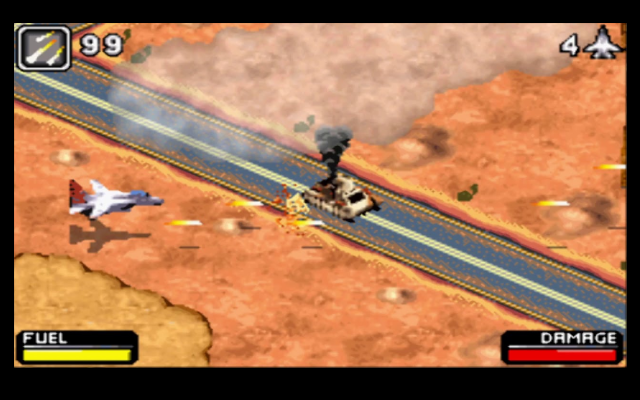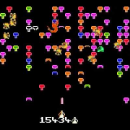After Burner II – The High-Speed Aerial Combat Classic That Defined Arcade Action

After Burner II, released by Sega in 1987, is a fast-paced arcade classic that put players in the cockpit of a fighter jet and immersed them in high-octane aerial combat. Developed by the legendary Yu Suzuki, After Burner II became a staple of the arcade scene thanks to its breakneck speed, thrilling dogfights, and impressive scaling graphics. It was more than just a game; it was an experience—complete with immersive cabinet controls in arcades, booming sound effects, and intense action. This arcade hit has since been ported to various home consoles, where it continues to captivate players with its timeless, adrenaline-pumping gameplay.
The Premise of After Burner II
The story in After Burner II is minimalistic and focuses primarily on delivering a non-stop action experience. Players take on the role of a fighter pilot in command of a powerful F-14 Tomcat, tasked with taking down waves of enemy aircraft across numerous stages. There is no deep narrative to unfold—instead, the game thrusts you directly into the action as you weave, roll, and blast your way through hostile skies.
The game spans multiple stages, each filled with enemy jets, helicopters, and ground forces that players must shoot down to advance. As the player, you navigate through various environments, including the open sea, mountain ranges, and deserts, all while facing increasingly difficult enemies that challenge your reflexes and combat skills.
Thrilling Gameplay and High-Speed Combat
What sets After Burner II apart from other games of its era is its high-speed combat and intense gameplay. From the moment you take off, the game pushes you into the heart of aerial combat at a blistering pace. The action is fast, fluid, and relentless, with enemies swarming the screen from all directions. Players must constantly maneuver their jet, dodging incoming missiles and bullets while simultaneously locking on and firing at enemy aircraft.
The controls in After Burner II are simple but effective. Players use a joystick to control the fighter jet’s direction, performing evasive maneuvers like barrel rolls and loops to avoid enemy fire. The game features two main buttons: one for firing the jet’s machine guns and another for launching heat-seeking missiles. The combination of these basic controls with the fast-paced action creates a thrilling and challenging experience that keeps players engaged.
One of the defining features of After Burner II is its sense of speed and intensity. The game uses Sega’s impressive scaling technology to create the illusion of 3D environments, making it feel like you’re truly soaring through the sky at high speeds. The backgrounds zoom by in a blur, while enemy jets appear and disappear in a matter of seconds, keeping you on your toes throughout the entire game. The adrenaline-fueled action never lets up, making each stage feel like a heart-pounding race against time and danger.
In addition to the fast-paced combat, After Burner II features smooth animations and dynamic camera angles that heighten the sense of immersion. The game constantly shifts perspectives, zooming in and out to follow the action, which adds to the intensity and makes each encounter feel cinematic.
Arcade Appeal and Portability
After Burner II was originally designed for arcades, and its deluxe cabinet was a big part of its appeal. The cabinet featured a hydraulic seat that moved in sync with the gameplay, tilting and rotating as you dodged and fired in the game. This immersive setup, combined with the booming sound effects and vivid graphics, made After Burner II a sensation in arcades worldwide.
The success of After Burner II in arcades led to multiple home console ports, including versions for the Sega Genesis, Master System, and later, Sega Saturn. While these ports couldn’t replicate the arcade cabinet’s immersive controls, they retained the fast-paced action and brought the intense aerial combat to living rooms across the globe. Despite the limitations of home consoles compared to arcades, After Burner II managed to maintain its charm and remained a beloved title in Sega’s library.
On the Sega Genesis, After Burner II shone as one of the console’s standout action titles. Though it couldn’t perfectly replicate the arcade experience, it successfully delivered the same rush of high-speed combat and intense dogfights that players had come to expect from the original.
Memorable Visuals and Soundtrack
Visually, After Burner II was ahead of its time. The game made full use of Sega’s sprite-scaling technology, which allowed for smooth transitions between different perspectives and made the fast-paced aerial action look and feel incredibly dynamic. The visuals, even in their pixelated form, still manage to convey a strong sense of speed and scale. The detailed enemy jets, explosions, and sprawling landscapes added to the sense of immersion, making players feel like they were in the middle of a high-stakes air battle.
The game’s sound design is another highlight. The iconic soundtrack, composed by Hiroshi Kawaguchi, features upbeat and adrenaline-pumping tunes that perfectly complement the fast-paced gameplay. The music is a key part of the experience, driving the action forward and making each battle feel more intense. The sound effects, from the roar of the jet engines to the sharp whine of missiles being launched, further enhance the game’s immersive atmosphere.
Cultural Impact and Legacy
After Burner II was a massive success in the arcade scene, solidifying Sega’s reputation as a leader in the action and simulation genres. Its unique combination of fast-paced aerial combat, immersive gameplay, and innovative use of arcade technology helped define the high-energy style that Sega became known for during the late 80s and early 90s.
The game’s impact extended beyond arcades, as it became one of the most popular and influential flight combat games of its time. After Burner II inspired many future titles in the aerial combat genre and helped establish a template for high-speed, arcade-style flight simulators. Its influence can be seen in modern action flight games that emphasize speed, spectacle, and over-the-top action.
Although After Burner II has since been surpassed by more modern flight simulators and combat games, its legacy endures as a beloved arcade classic. The game has been re-released on numerous platforms over the years, including the Sega Saturn, PlayStation 2, and modern consoles as part of Sega’s various collections. Its enduring popularity speaks to its timeless appeal and the lasting impression it left on gamers.
The Art of High-Speed Arcade Action
What made After Burner II so memorable was its ability to deliver a high-speed, adrenaline-fueled experience that was unlike anything else in arcades at the time. The game’s focus on fast-paced combat, combined with its simple yet effective controls, made it accessible to players of all skill levels. At the same time, its relentless action and challenging gameplay ensured that players would keep coming back for more.
The success of After Burner II lies in its ability to create an immersive, thrilling experience with limited technology. Sega’s use of scaling graphics and dynamic camera angles helped elevate the game beyond a simple flight simulator, transforming it into an action-packed, cinematic experience that has stood the test of time.
Conclusion
After Burner II is an arcade legend that redefined what players could expect from aerial combat games. Its fast-paced action, stunning visuals, and adrenaline-pumping soundtrack created an unforgettable experience that captivated arcade-goers and console players alike. Whether you’re revisiting this classic or experiencing it for the first time, After Burner II offers a thrilling ride that continues to deliver excitement and fun. So, strap into your jet, prepare for takeoff, and get ready for the aerial dogfights of After Burner II—a game that never gets old.







